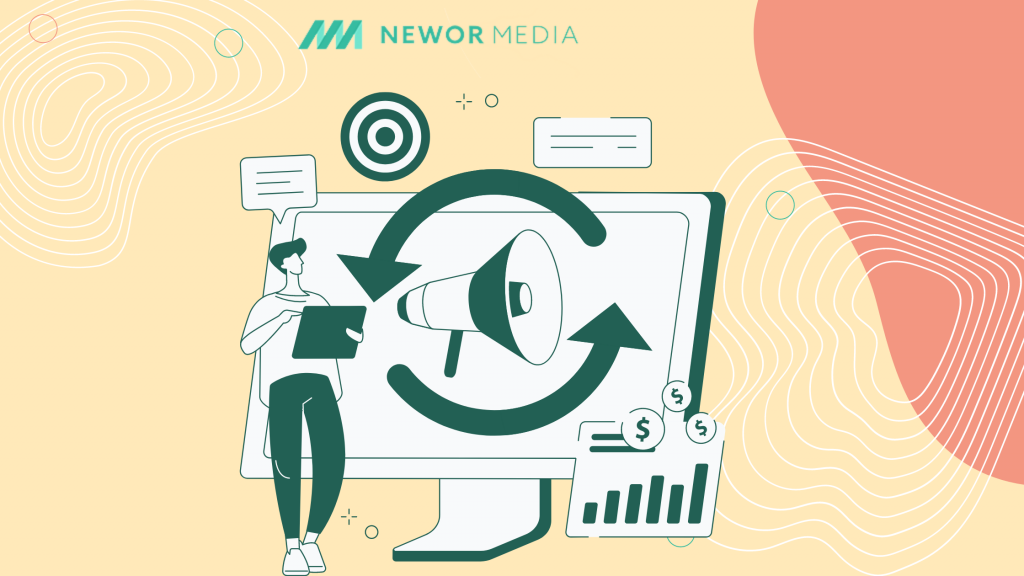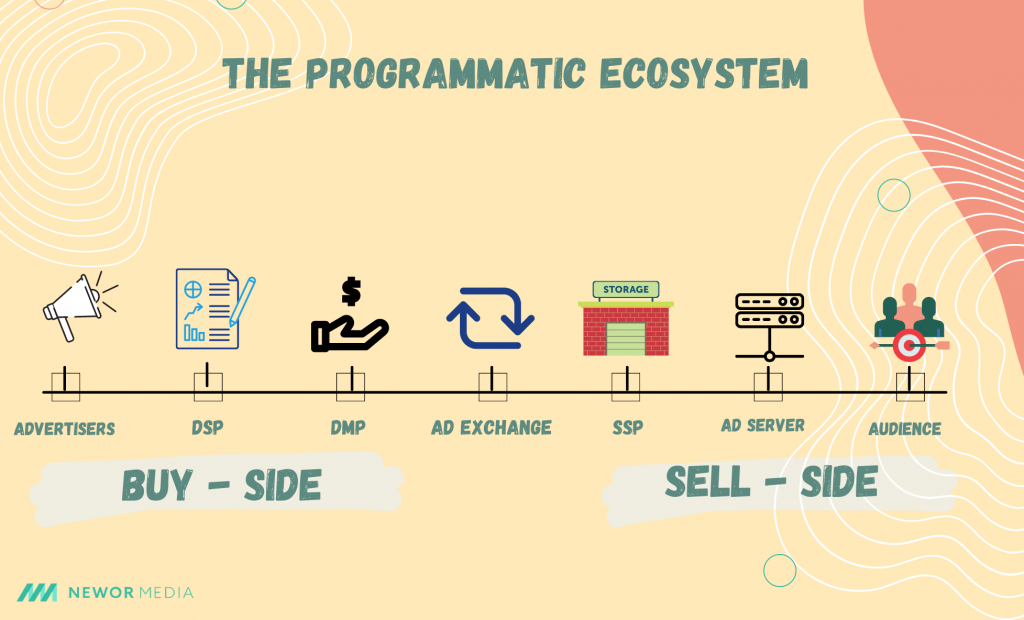
Programmatic marketing has drastically changed the ad-buying landscape. Lucky for you, there’s never been an easier time to sell ad space and earn passively with ads.
Traditional selling methods (such as manual and direct ad sales) come with challenges that lead to errors, frustration, and wasted time for publishers. Instead, programmatic tech cuts out the need for publishers to locate buyers, negotiate prices, and integrate technology onto their websites.
In addition to streamlining the process for you, programmatic tech can assist with ad optimization. Gone are the days of fretting over ad placements and what ad formats to use. Alternatively, publishers are given real-time insight and transparency into their ad strategy and more control to improve it. As a result, programmatic advertising is critical for those looking to maximize earnings.
How does programmatic advertising work?
Programmatic advertising uses software and machine learning to automate the ad buying and selling process. It allows companies to bid and purchase ad impressions on publishers’ websites in real-time. Beyond standard buying and selling, algorithms work to serve ads to the right user at the right time.
The programmatic ad ecosystem effectively cuts down the effort, error, and time experienced by other traditional digital advertising models. For example, the ad tech will streamline automation, removing the typical work of request proposals, insertion orders, and negotiation. Instead, artificial intelligence (AI) drives decision-making on both the sell and buy-side — taking humans out of the driver’s seat. So, rather than having to market and negotiate your ad inventory with advertisers, the software will do it on your behalf and instantaneously!
The programmatic ecosystem
What does it take to create a nearly instant media buying process? Surprisingly, not as much as one would think. The ecosystem that makes up programmatic advertising consists of several software types and platforms. It’s a streamlined loop at its core — auctioning publisher inventory, serving winning ads, and reporting feedback to advertisers. But let’s take a deeper dive (tech-jargon included!):
- Ad Exchange – A marketplace for ad networks and publishers; where buying and selling occurs
- Data Management Platform (DMP) – software that collects and segments third-party data for advertisers; advertisers use the data to improve ad campaigns
- Demand-Side Platform (DSP) – an advertiser tool; automation software that allows advertisers to buy ad impressions/space
- Supply-Side Platform (SSP) – a publisher tool that holds inventory; automation software that enables publishers to sell ad space to potential buyers
- Ad Server – tech that stores and serves an advertisement
The buy-side ecosystem
- A user visits a webpage, triggering an auction signal to the ad exchange
- The ad exchange then notifies the DSP that ad units are available for bidding
- -The goal of the DSP is to buy ads at the lowest cost to advertisers
- The DSP will communicate with the DMP to obtain further information for decision making
- – In addition to collecting and organizing data, a DMP uses data to fuel ad-buying decisions
- If prompted, the DSP will bid on the ad space
- Ad servers then show the user the advertisement of the winning bid

The sell-side ecosystem
- Publishers put their ad space up for auction, which is held in an SSP
- The role of an SSP is to get the highest price for publishers
- Publishers don’t directly work with SSPs. Instead, ad networks serve as the middleman between the two.
- A visitor loads a webpage, triggering the auction
- The SSP sends the inventory to the ad exchange
- The bid happens instantaneously, and the highest bid wins the inventory
- An ad server will then show the winner’s advertisement to the web-user
Benefits of programmatic advertising
Programmatic advertising helps improve on several of the limitations and errors associated with traditional media buying.
The benefits for advertisers are:
- Scaling: Programmatic advertising supports multiple ad exchanges, allowing advertisers access to more inventory. As a result, advertisers can reach a larger audience and serve more impressions.
- Real-time analytics: Real-time data allows advertisers to assess and improve upon their campaigns while they’re happening. This allows for optimization, leading to a better return on investment (ROI).
- Enhanced targeting capabilities: DMPs constantly collect and organize real-time data to drive buying decisions. As a result, target audiences and demographics are better profiled and effectively reached.
The benefits for publishers are:
- Simplicity: Automation allows publishers to make earning as hands-off as they’d like. SSPs and a more extensive network stack will drive competitive rates and complete selling and serving for you.
- Improved relevancy and fill rate: Since advertisers have better targeting abilities, users are served ads that they’re more likely interested in or will want to engage with. In addition to better user experience, it also improves engagement rates—which is more money in your pockets!
- Ad fraud prevention: programmatic tech provides ad fraud solutions, such as blockchain and ads.txt files. This can help decrease/eliminate malvertising, redirects, and money loss to ad fraud.
- Effectiveness: Machine automation significantly reduces the margin of error in integrating networks, negotiating prices, and serving ads. Additionally, some platforms provide extra services that assist with ad optimization— including ad layout optimization, ad format variety, A/B testing, and more. As a result, publishers get high-performing ads without the burden of optimizing falling onto their shoulders.
Types of programmatic advertising
There are various types of programmatic channels. Whether you have access to all solely comes down to the ad partner you choose to work with. Because programmatic advertising is so lucrative, we’d recommend working with a partner who can do it all— to secure yourself the most money!
Each type operates differently and comes with its own set of pros and cons. So, brushing up on the four main types of programmatic advertising will help you find what best suits your needs.
Real-Time Bidding (RTB)
Real-time bidding (RTB) is the most widely used programmatic type. As the name suggests, RTB creates an instantaneous auction — buying and selling within milliseconds! This allows publishers to serve more impressions at a quicker rate. As a result, advertisers focus a great deal of their ad spend budget on RTB.
The real-time auction is often referred to as open marketplace or open exchange because any ad network can bid on any website. In turn, it increases competition for advertising space, resulting in higher payouts for publishers.
Private Marketplace (PMP)
Private marketplace is similar to RTB because both occur in a bidding fashion. However, unlike RTB, the auction is open to select advertisers only. This enables advertisers to know what publisher sites they’re biding for and vice versa.
PMP is also known as private exchange or invitation-only. It helps advertisers connect to a more relevant audience and niche. Publishers benefit with more competitive rates.
Preferred Deals
Preferred deals give advertisers ‘first-dibs’ on ad space. Before being sent to auction, select advertisers will get a first look at the inventory. Then, they can decide to purchase it for a previously agreed-upon amount or deny the request.
Although it can help publishers work with advertisers of their choosing, preferred deals don’t guarantee purchase. As a result, they’re also called programmatic non-guaranteed.
Programmatic Guaranteed
Closely related to traditional media buying, programmatic guaranteed is the practice of publishers and advertisers working one on one to create deals. However, it still uses AI tech to automate ad requests, serving, and tracking. It’s also referred to as programmatic direct or automated guaranteed.
It can be challenging to work your way up to this type of programmatic advertising—it’s relatively exclusive! However, quality traffic and engagement is a sure way to raise the value of your websites or apps. Programmatic guaranteed often yields high cost-per-impressions (CPMs) rates.
How to monetize your website using programmatic advertising
So how do publishers ditch traditional display networks and waterfall methods and upgrade to programmatic ad buying?
It’s a relatively straightforward process with little-to-no heavy lifting for publishers. Firstly, publishers need to ensure they have decent traffic. Each platform will have a set requirement of monthly traffic or pageviews to join. Once you have decent traffic, sign up for a programmatic advertising platform and integrate them onto your website. Integration is as simple as creating an account and using a WordPress plugin or following quick steps to insert a code onto your site. Immediately, all the programmatic technology will begin working to sell your digital media space — no effort required from you.
In addition to streamlining your online ad selling, many platforms offer more to help optimize ad space. For example, traditional buying and selling can be very limiting— same old display ads and placements. Programmatic ad platforms offer a wider variety of ad types that help increase engagement and viewability (such as rich media ads and video ads). So on top of providing a more efficient selling process, publishers also get better variety and performances.
Why can programmatic advertising be so successful?
Programmatic display advertising is a more effective, scalable, and error-free way of conducting digital advertising. The system works so well because of its flexibility. Unlike other traditional campaigns where digital marketers could only measure campaign success after completion, programmatic advertising gives real-time data and metric reporting. Consequently, it allows them to change strategy for a more significant impact. In addition, better targeting capabilities enable ads to reach the right audience at the right time. As a result, fewer resources are needed for maximum results.
The improved ROI is undeniable. For example, a recent eMarketer report projected programmatic advertising to account for 86.5% of total digital display ad spending in the US for 2021 alone.
Header bidding for publishers
Programmatic marketing is a significant improvement from older (dare we say, outdated) models, but not all programmatic advertising is equal. For example, Google AdSense uses programmatic tech to automate its auctions— and yet, most publishers struggle to scale with Google ads. Why? Because a small network stack is insufficient for driving any real competition.
Header bidding is a must-have publisher tool for online advertising. It’s the technique of auctioning off digital ad space to an array of ad exchanges simultaneously. So rather than ads going to one demand pool and only receiving bids from it, they’re bid on by many. It effectively increases competition and drives revenue up.
Conclusion
Digital advertising comes with its challenges but is incredibly lucrative for those who can hack it. Programmatic advertising is just one of the tools that can assist publishers in crafting a solid ad strategy— and earning a nice chunk of money.
Consider programmatic advertising and header bidding to:
- Make earning more passive
- Serve better quality and more relevant ads
- Maximize earnings

5 Comments
Comments are closed